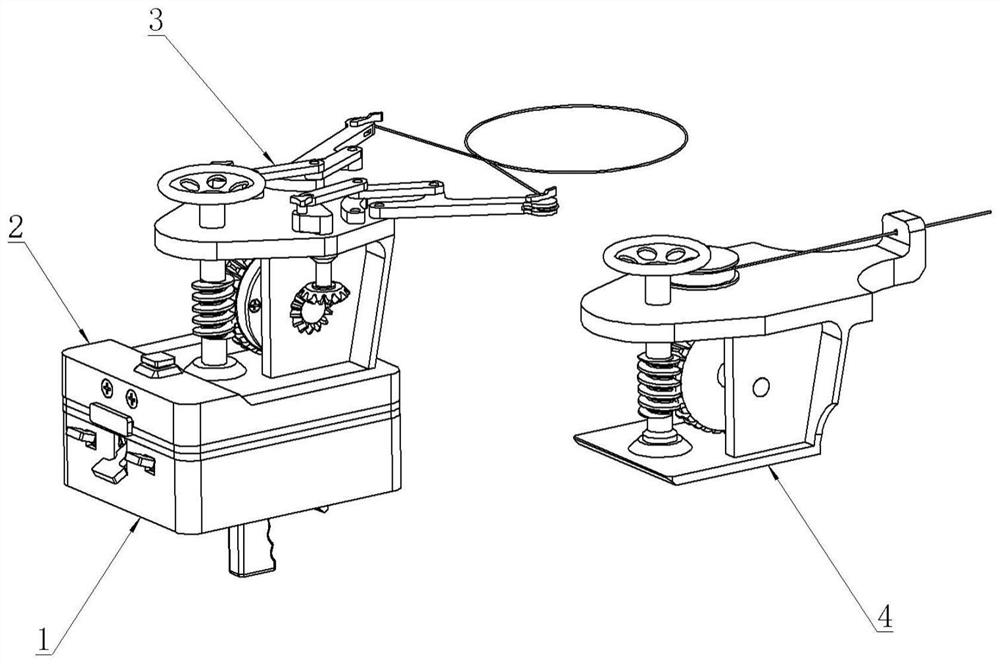[0006] 1) One of the above-mentioned equipment cannot solve the operation involving the extraction of two single wire ends. In this case, only two
medical staff can be used to operate two of the above-mentioned equipment to participate in the operation, which not only wastes medical resources, but also occupies the
working space of the chief surgeon, reducing surgical efficiency;
[0007] 2) Patella repair
surgery will determine a wire binding method according to the actual fracture situation, and the number of wire ends is also determined. In the technical solution involved in the above-mentioned invention patent, the single wire end tensioning mechanism and the double wire end The tensioning mechanisms are respectively located at both ends of the rotating mechanism, that is, the above-mentioned equipment has both a single-thread tensioning mechanism and a double-thread tensioning mechanism, and only one tensioning mechanism is used in the operation, and the other tensioning mechanism It must be idle. Since the above-mentioned equipment is operated by hand, the idle tensioning mechanism not only occupies the operation space, but also increases the load on the arms of the
medical staff when operating, increasing the burden on the
medical staff;
[0008] 3) With reference to paragraphs [0065], [0066], and [0067] of the description of the above-mentioned patent documents and Fig. 23, Fig. 24, and Fig. 25 in the drawings of the description, it can be seen that because it adopts the active
helical gear (312) The first sleeve (311) and the second sleeve (313) with driven
helical teeth (314) are driven, and the technical effect expected to be realized is one-way transmission, which cannot rotate in reverse; because in the process of tightening the steel wire, Before tying the ends of the steel wires, the chief surgeon needs to try the tightening force several times to achieve the best effect on the restoration of the bone suture. The equipment involved in the above-mentioned patents cannot achieve the technical effect of loosening the steel wires. Only the hand-tightening bolt 1 (214) or the hand-tightening bolt 2 (227) can be opened to loosen the compressed steel wire head, and the initial state of the above-mentioned equipment can be restored. , to re-tighten the end of the compressed steel wire, which not only seriously affects the efficiency of the operation, but also causes secondary damage to the damaged patella;
[0009] 4) Since the driving
helical teeth (312) and the driven helical teeth (314) are actually
ratchet transmission structures, and the number of teeth is fixed, the minimum number of steps that can be realized by one round of circumferential rotation is also fixed, which cannot be achieved Stepless transmission, therefore, one less step is too loose and one more step is too tight during the operation. Even if the number of helical teeth is increased, the degree of looseness or tightness can only be reduced, and cannot be completely eliminated. Moreover, the number of teeth increases , the tooth shape will become smaller, and the material has a
stress limit, so the number of helical teeth cannot be infinitely increased;
[0010] 5) With reference to the technical features described in
paragraph [0065],
paragraph [0066] and
paragraph [0067] of the above-mentioned
patent document description, it can be seen that there is no self-locking transmission between the transition gear one (315) and the
drive shaft 238 structure, therefore, the technical effect in paragraph [0065] "When the driving helical tooth 312 rotates in reverse, the driving helical tooth 312 will press the driven helical tooth 314 and make the sleeve two 313 float away from the sleeve one 311 "It cannot be realized, because after the steel wire is tightened for the first time, there is a certain tension in the steel wire, which will cause the driven helical tooth 314 to have a tendency to rotate in the opposite direction. Furthermore, the floating spring 317 pushes the sleeve two 313 to the top Tight to the second sleeve 313, therefore, the actual situation is that when the active helical gear 312 rotates in reverse, the second sleeve 313 will not float away from the first sleeve 311, but reversely rotates together with the active helical gear 312, so that the retraction The tight steel wire is loosened, and the technical effect of repeatedly pulling the
wrench 305 to tighten the steel wire cannot be achieved. Such technical defects make the technical solution involved in the above patent unable to achieve its technical purpose, let alone solve the problems existing in the prior art. insufficient
 Login to View More
Login to View More  Login to View More
Login to View More 









